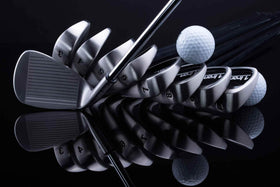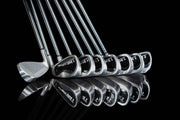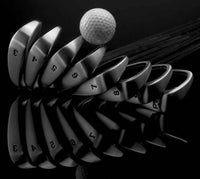The Truth About Golf Shaft Flex
by David Lake
There is no standardization in the golf industry as to shaft flex which means that one brand’s stiff flex shaft might be the equivalent of another brand’s regular flex shaft, and a particular brand’s regular flex shaft might be the equivalent of another brand’s senior flex shaft, and so on. Add to this the fact that the shaft flex designation does not represent a single flex, but rather, a range of flexes that have arbitrarily been assigned to a particular flex designation. For instance, average frequency ranges in steel iron shafts range from approximately 270 cpm for an A-flex shaft to approximately 340 cpm for an X-stiff flex shaft (based upon a typical #5 iron). This 70 cpm difference is arbitrarily divided up into ranges and assigned the flex designations we are used to seeing, but bear in mind that the various shaft brands divide this range up differently, and in any case, there is no exact cpm for any particular shaft flex, but rather, a cpm range. Consequently, a golfer stating that he plays “stiff” flex or any other flex designation can be, and usually is, very much mistaken.
There is a story concerning Jack Nicklaus where he bent his #8 iron (his favorite iron) during a tournament round. He took it to the tour van to replace the shaft and told the technician that it was a stiff shaft. Upon testing, the technician told Jack that it was, in fact, a regular flex shaft. Jack berated the technician for a few minutes that he should ever question him in the matter of golf so, in the end, the technician put in a stiff shaft. Jack came back later and complained that the club did not feel right and that the technician had screwed up, so the technician went ahead and replaced the shaft with a regular flex shaft without telling Jack. After winning the tournament Jack came back and praised the technician for a job well done.
Another point which most golfers do not realize about shaft flex in a conventional varying length set of irons is that, regardless of what the shaft bands state as to flex, every one of the irons in the set has a different flex getting progressively stiffer from the #3 iron to the wedges. Effectively, the “long” irons would be A-flex progressing to R-flex in the “middle” irons and then to S-flex and X-stiff in the “short” irons and wedges. To prove this to yourself simply hold the clubhead of a conventional #3 iron in one hand with the grip in the other hand and bend it – then do the same thing with the PW from the same set and you will see exactly what I mean (In a set of 1 Irons the shaft flex/feel is identical throughout the set).
Our shafting method is completely different than any other brand of golf clubs in the golf industry in that we do not shaft our golf clubs based upon arbitrary flex ratings, but rather, upon precision balancing. We only offer our optimized shafts in our lines of 1 Iron single length golf clubs for which the design of our golf shafts in combination with our proprietary Shaft Optimization Process produces a perfectly balanced golf club (all other brands use stock shafts with no balance criteria whatsoever). Once this perfect balance is achieved the concept of shaft flex (frequency) disappears and the golf club will perform at its peak performance level regardless of swing speed or strength. You can liken it to a precisely balanced bull whip where there is a perfect transfer of power along its length from the butt to the tip regardless of the strength of the person using it.
Our 1 Irons have been played by professional golfers and long-drive champions with extremely high swing speeds and are played by senior men and women golfers with very low swing speeds. In either case the golfer realizes their optimum distance, trajectory, and control/accuracy. The results of our studies and testing over the past two decades have shown that our shafting method produces the highest level of performance for any golfer. It might be interesting to note that we have never had a comment of our shafts feeling stiff or weak in over 20 years. The only comments that we receive, and we receive them daily, are that our clubs just feel right.
Also, we are the only golf club manufacturer to perform shaft flex plane orientation (spine aligning/puring) as part of our proprietary Shaft Optimization Process. If an iron is shafted without regard to its inherent flex plane the shaft will try and rotate around its axis to a position of stability during the swing which creates an oscillation of the shaft and club-head. This oscillation results in the club-head literally wobbling through impact. When the shaft is correctly oriented in respect to its inherent flex plane it will resist twisting to any other position when placed under load and will remain stable through impact. It is as if the club-head is riding on rails through the impact zone.
Why is it that we are the only golf club manufacturer who uses this approach to shafting? Simply stated – cost versus profit. Our proprietary Shaft Optimization Process adds numerous additional steps and associated costs into the club building process that no other brand wishes to incur. However, our goal has always been to produce the highest performance golf clubs in the industry, and we will always do whatever it takes to achieve this goal.










